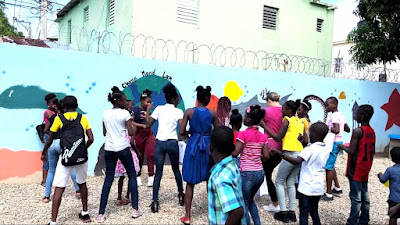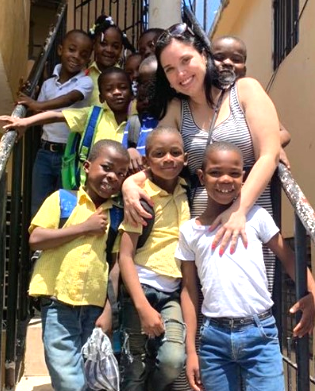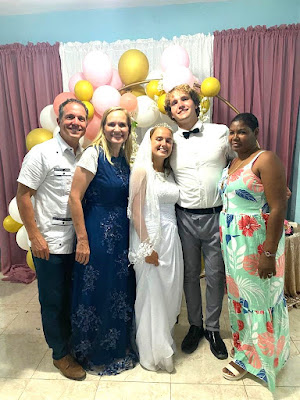Darrel L. Hammon
Not long ago, I was talking to Trisha, a good friend who is a stay-at-home-mom (SAHM) with a master's degree and now writing a book about being adopted. We talked about the "job titles" and skills SAHMs need to have to survive while being stay-at-home moms.
Consequently, I asked this question of my followers via social media, some of them SAHMs: "If you were to build a résumé for a stay-at-home mom what components, skills, experiences, etc. would you include as part of this overwhelming job?
My asking the question and ultimately writing this article was/is not to “glorify,” or even “hero-i-fy” SAHMs. Rather, it is to acknowledge and validate their enormous contributions and talents and give them credence for having chosen to be stay-at-home moms in their own homes when they could have easily been out serving as leaders in corporate America. As Trisha so deftly stated, “I have chosen Motherhood as my career, but it is exhausting!”
 |
| SAHM Trisha, master's prepared Early Childhood Development |
The responses to my question were overwhelming, the majority coming from SAHMs. They were diverse, funny, professional, profound, exact, insightful, inspiring, practical, and awe-inspiring. Their answers made me tired just reading all the things that SAHMs do every single day.
Think of this partial list and not in any particular order or hierarchy:
Counselor/Therapist—How many times have we talked to our mothers about everything and cried on their shoulders over breakups, bad test scores, and pets and animals dying?
Healthcare provider—It’s a wonder children even survive from bike wrecks, skinned knees, broken legs and arms, falling off swings, and a host of other accidents.
Gardner/landscaper—We have all wanted to plant something, and then mother had to take care of it and not because she wanted to do it. She just hated for something green to die.
Chef/restaurateur—So many of us may have complained about what our mother made or created for meals, but I suspect most of us have called home for the recipe of something she had made or craved that special dish that only our mothers made.
Entrepreneur—How many little businesses have mom helped us with? I know my mother helped my siblings learn how to be lawnmowers and nightcrawler sellers, and lemonade stand operators.
Caregiver—Moms are caregivers to everyone—family, neighbors, cats, dogs, piglets, calves, and anyone who needs help.
Teacher/tutor/mentor—Moms have become teachers of every subject in school. Often, she would study harder than we did just so she could help us with some esoteric problem that we need to do.
Motivator/cheerleader—No one can count the number of ballgames, soccer and tennis matches, speech and drama events that our mothers have attended, no matter how boring, no matter the weather, no matter the place, and she brought treats for everyone.
Chauffer/taxi— Our mothers log thousands of miles in taking us everywhere we need to go to help us participate in and attend activities. Most of the time, we are just in the back of the car, doodling, singing, playing, listening to music, reading, and probably not paying attention. Yet, our SAHMs safely maneuver our vehicles through rain, snow, sleet, and dreary days.
Entertainer—My mother was an entertainer. She danced. She laughed. She sang. She even did yoga. Plus, some SAHMs read bedtime stories as if they are performing before a large audience. That’s why kids love to be read to. It’s entertaining and soothing simultaneously.
 |
| SAHM Amanda with her young family |
Mediator/arbitrator—Good thing moms know mediation and arbitration. They all should receive honorary law degrees and mediation certificates for all of the challenges and hot water she got us out of, and that was all before dad arrived home.
Handyperson—Plumbers, electricians, sheet rockers, home repairers, etc.—Have tool kit, and SAHMs are in their element. I suspect most of them did not realize what they were up against when they first had children. But, alas, they had to become fix-it-everything. Instead of Disney calling it “Fix-it-Ralph,” they should have named the movie, “Fix-it-Regina or Rachel.”
 |
| No walls? No problem!" said SAHM Sandra Dee |
Performance reviewers—From piano, cello, and violin recitals to plays to dance festivals, SAHMs have always had to review how everyone did. As you watch children greet their parents after they have performed, their first words are, “How did I do?” usually looking directly at their mothers.
Audience—“Mom, watch this!” And then our SAHMs would watch whatever “creative” thing we showed her, usually without rolling her eyes—at least that we ever saw.
Art critic/reviewer—SAHMs have seen more art on paper, on the sidewalks, and on the walls than real art critics and reviewers. I wish SAHMs had taken photos of their fridges over the years to validate all of the art we did have. Ironically, my mother saved a few of my art pieces that I now cherish but never show anyone.
Laundry specialists—My own mother, a SAHM, had eight children. She even had a clothesline outside that usually had some type of washing hanging from it. And they smelled so good. Now, the smell is Downey or some fabric soften. I think I prefer the outdoor, wind-driven smell. Sometimes I wonder how many batches of laundry SAHMs do per week. Countless!
Researchers— SAHMs spent too much time trying to find things for all of us. Think of the reports, papers, and speeches that she helped you with throughout your schooling. Now with Google and other search engines, how much time does she spend searching for less expensive things or of better quality?
Preachers/clergy—Ah, the confessions our SAHMs heard from our repentant lips, knowing all along we would repeat the infractions the very next day, if not that very afternoon.
Vet techs—Animals get sick, and SAHMs know how to heal animals.
Probation officer/police chief—Yes, we all were on probation, time out, or grounded at some point in our lives, even for weeks and months. It was our SAHMs who had to endure the clanging of the jail cells and the moans from our lips that she wasn’t being fair. But she was persistent and consistent in metering out the punishments.
Problem solver—Are there books out there written by SAHMs for other SAHMs? They just seem to know how to solve every single problem that arises. Mostly, though, they help us solve our problems so that we can become better problem solvers in the future.
Crisis and conflict management consultant—During our growing up years, crises seem to pop up every single day, and usually, the first person we approach to help us is our moms. When moms are SAHMs, they have to deal with every crisis, large or small. Amazingly, they guide us through them. That’s why SAHMs are crisis management consultants. They know how to help us manage the crises in our lives.
Lifelong learners— Most SAHMs never quit learning, no matter how much education they receive before coming mothers. They have to keep up with the times and help their children with the never-ending newness that seems to emerge every year. One such mother is Sandra Dee. She stated that she “didn’t quit learning.” Rather, she learned how to fix computers, frame closets, hang sheetrock, renovated rooms, install electrical outlets, change the oil in cars, and a host of other trades. She ended with “I have learned that being a full-time mom isn't always appreciated, but I wouldn't trade it for any other job in the world.” Her daughter followed in her footsteps.
 |
SAHM Sandra can fix or repair anything
with the help of classes and YouTube videos! |
Computer technologist—This is a new one. Some SAHMs do not have this skill although the last couple of generations of SAHMs are much better because they have learned technology in their youth. I believe, however, that the best thing they could have done is taken the devices away for a while.
Planning and activities specialist—Party planner, soccer and basketball practice planner, test planner, food planner, birthday party planner, and host of other event planning. SAHMs know how to plan.
Organizer—How many of you could ask your SAHMs where something was, and she knew exactly where it was at any given time? She probably knew where everything was because she was the one who had to finally put it in a safe place, instead of having it scattered throughout the house.
Chief executive officer (CEO)—In several homes, the SAHM becomes the CEO because she is also a single parent, trying to manage the entire household, delegating chores and responsibilities, and teaching her children how to do so many tasks that children need to learn to become viable citizens in the future. Her family is her team and organization.
Chief operational officer (COO)—Literally everything that happened in our house, my SAHMs seemed to be in charge and guided us in getting things done. Our garden was huge, and at harvest time, she seemed to know everything about canning, bottling, cooking, preparing, and harvesting.
Chief financial officer (CFO)—Most SAHMs seem to be in charge of everything dealing with money and finances, even figuring out financial aid for college, helping set up saving accounts, and creating jobs to help us earn money.
Communication specialist—Who taught us to talk, speak on the phone, talk politely to our neighbors, say kind words to our siblings (or at least how we should do it), say the right words at the right time, slow down when we talk to fast, not talk with our mouths full, and more communication nuances.
Homework reviewer—We all had homework. Someone had to review it, whether it was math, language arts, reading, science, social studies, history, or whatever, SAHMs reviewed it and even taught maybe a more effective way although our teachers didn’t like it.
Jack of all trades—Overall, SAHMs know how to do everything—or so we thought and keep sacred in our minds and remembrances. Now, we wish we could have been like them in every way.
 |
| One SAHM Sandra added the rock tiles; tiled the floor and stairs;
sheet rocked, insulated and painted the walls; and finished the stair railing. |
And many, many, many more titles!
Tana, a master’s prepared speech therapist with several children, many of them adopted from various countries, described SAHMs in such an elegant and factual way: “So I think most SAHMs could probably describe themselves as able to respond gracefully to unwarranted criticism. We could also pretty much universally say that we work well under pressure from internal and external sources, adjust quickly to changing responsibilities with little or no notice, and are excellent prioritizers. I want people to understand that I made this choice because it was what I wanted.”
 |
| Family of Tana, a master’s prepared speech therapist |
At some point, may SAHMs want to return to the workplace. Tana penned a message for Human Resource personnel: “For a former stay-at-home mom getting back into the workforce, it can be really tough to get employers to take these skills and abilities seriously, and that's a travesty. Yeah, the woman may not be up on the latest version of Excel or may not have a thousand LinkedIn connections, but so what? Her abilities are time-tested, HONED, and she is battle-ready. She knows how to WORK, and even better, she knows how to get results. Give her a chance, Ms. Human Resources, and let her do her thing!”
All you SAHMs, you are the best, you are phenomenal, and you are inspiring to all of us, and we thank you for being so wonderful for what you do as stay-at-home moms. We are just happy that you choose to do all things—all the while smiling and being positive! We believe in you!




























.png)
.JPG)









.png)
.png)









